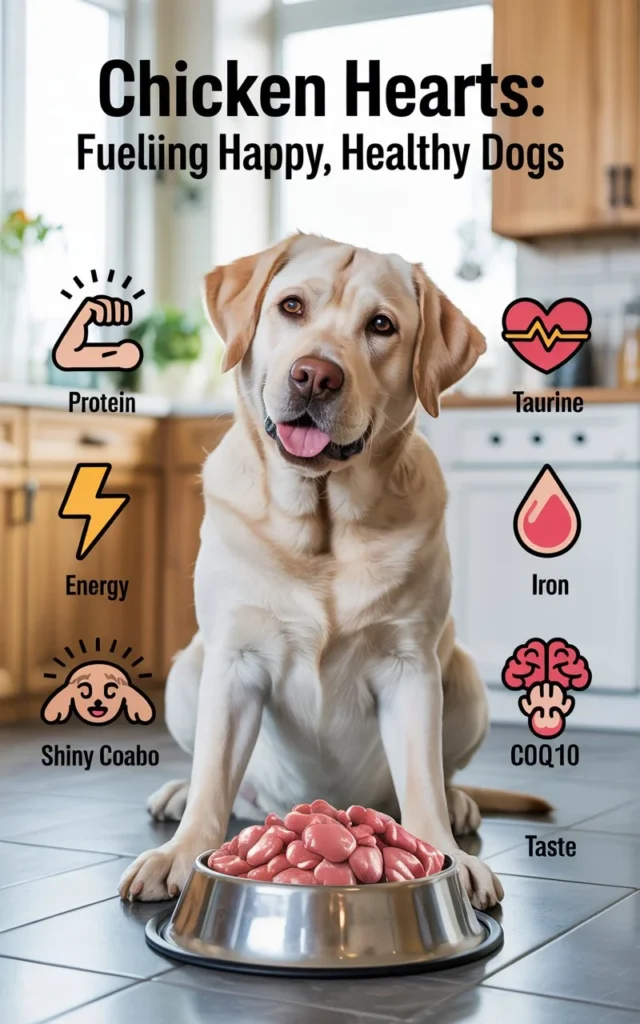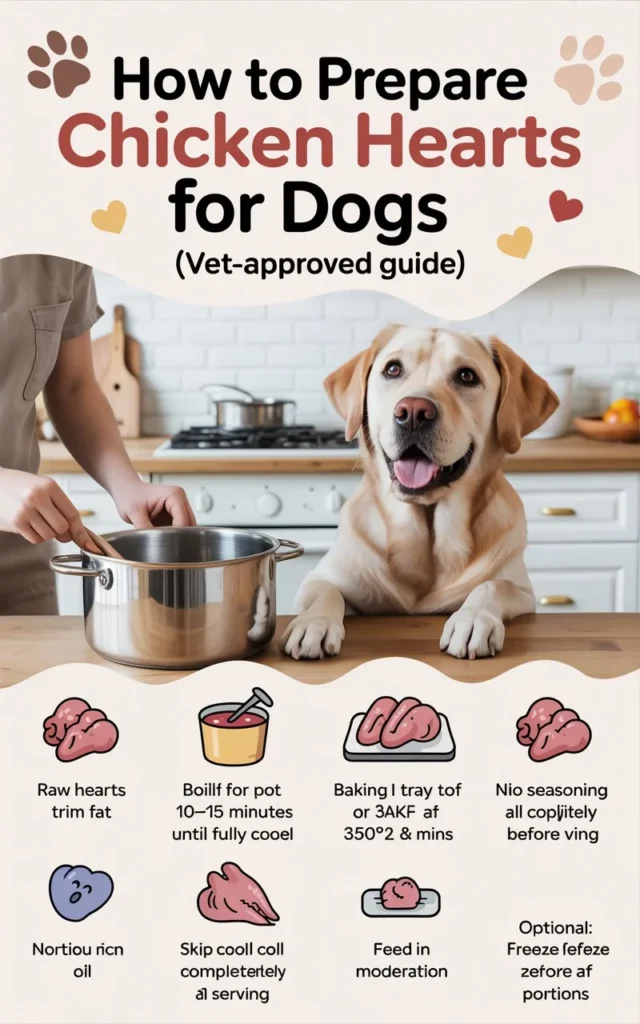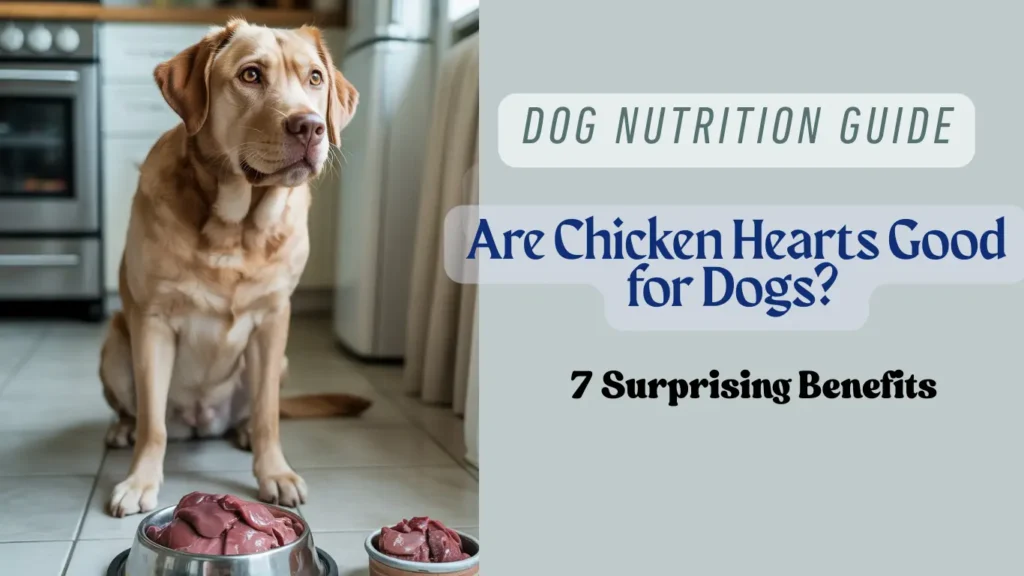When I first gave chicken hearts to my dog, I wasn’t sure if he would like them. But he sniffed them once, took a bite, and wagged his tail like crazy — he loved them! That’s when I started to learn more about whether chicken hearts are good for dogs. They’re full of protein, vitamins, and something called taurine, which helps keep your dog’s heart strong.
In this article, I’ll share the benefits of chicken hearts for dogs, how to cook them, and answer questions like “can dogs eat chicken hearts?” or “are chicken hearts safe for puppies?” Let’s find out what makes this little snack so special!
What Are Chicken Hearts — And Why Are They in Dog Food?
Chicken hearts are tiny but mighty! They come from the inside of a chicken and are about the size of a thumb. These little hearts are full of good stuff like protein, iron, and B vitamins, which help keep your dog strong and full of energy. Chicken hearts are rich in nutrients and support your dog’s health.
Many dog food brands use chicken hearts because they are healthy and tasty. You’ll often see them in commercial dog foods and even in raw diets. Dogs love the chewy texture, and it gives them a break from boring old kibble. Chicken hearts are added to dog food because dogs enjoy them and they’re packed with nutrition.
One of the most important things in chicken hearts nutrition for dogs is something called taurine. Taurine helps your dog’s heart stay strong and beat just right. It’s also good for their eyes and brain. Taurine in chicken hearts for dogs helps protect their heart and brain.
So, even though they might look a little strange, chicken hearts are a smart choice for your dog’s bowl — full of goodness from the inside out!
Can Dogs Eat Chicken Hearts?
Yes, dogs can eat chicken hearts — and most of them love it! The first time I gave my dog one, he looked at me like he’d just won the jackpot. These little treats are full of good stuff, but they need to be given the right way to keep your pup healthy and happy. Chicken hearts for dogs are safe when you serve them plain, with no salt or spices.
Feeding Chicken Hearts Safely
To be safe, always cook or freeze chicken hearts before giving them to your dog. This helps kill any bad germs that could make them sick. You can boil them, pan-fry them with no oil, or even dehydrate them as chewy snacks. Dogs can eat chicken hearts, but they should be fresh and clean.
Puppies vs. Adult Dogs
Both puppies and grown-up dogs can enjoy chicken hearts, but you’ll need to start slow with young pups. When my dog was still little, I gave him just a small piece at first to see how his tummy handled it. For puppies, soft and well-cooked pieces are best. Chicken hearts for puppies are safe when introduced slowly and cut into tiny bites.
Right Size, Right Portion
Don’t overdo it. These treats are small but full of nutrients. A big dog might be okay with one or two whole chicken hearts, while a small dog may only need half. Think of them like vitamins — a little goes a long way. Serving the right amount of chicken hearts for dogs helps avoid tummy trouble and keeps their diet balanced.
Top 7 Benefits of Chicken Hearts for Dogs

1. High-Quality Protein Source
Chicken hearts for dogs are packed with protein — and not just any kind. It’s the kind that helps build strong muscles and keeps your pup bouncing with energy. Did you know that just 1 ounce of chicken hearts has about 7 grams of protein? That’s almost the same as a whole egg!
When I first added them to my dog’s meals, I noticed he seemed fuller longer — and his tail wagged more during walks. Protein really is the power behind the play!
2. Rich in Taurine for Heart Health
This is the real star. Taurine is an amino acid that helps your dog’s heart beat strong and steady. Some breeds, like Golden Retrievers and Dobermans, need extra taurine to help avoid heart problems like DCM (Dilated Cardiomyopathy).
According to one USDA estimate, chicken hearts contain about 60–70mg of taurine per ounce. That’s like giving your dog a little heart hug with every bite.
3. Boosts Energy and Metabolism (B Vitamins)
When my pup seems a little sluggish, chicken hearts perk him right up. That’s because they’re full of B vitamins, like B12 and riboflavin, which help turn food into fuel.
One ounce of chicken hearts has about 5 micrograms of B12, which supports nerve health and energy levels. It’s like nature’s little multivitamin — but tasty!
4. Iron for Better Oxygen Delivery
Iron helps red blood cells carry oxygen through your dog’s body. That means more energy, better stamina, and healthier organs.
Each ounce of chicken hearts contains around 2.4mg of iron — more than beef liver! When I added them to my dog’s diet, I noticed he tired less quickly during long play sessions. It’s amazing what better blood flow can do.
5. Supports Skin and Coat Health
Chicken hearts also bring the shine! They contain zinc and B vitamins, which keep your dog’s skin smooth and their coat soft and shiny.
My dog used to have a dry, itchy spot behind his ear. Once I added chicken hearts a few times a week, it cleared up. Coincidence? Maybe — but I’m convinced it helped.
6. Natural Source of CoQ10
Here’s a bonus benefit you might not expect: chicken hearts are full of Coenzyme Q10 (CoQ10). This nutrient supports heart health and may even boost brain function.
Some research shows that dogs given extra CoQ10 had better heart strength over time. It’s like a secret weapon for senior pups who need a little extra support.
7. Great Taste — Even for Picky Eaters
This one might be my favorite: dogs love the taste. When nothing else works, chicken hearts do the trick. My dog was such a picky eater as a puppy — until he tried these chewy little hearts.
They have a meaty flavor and a chewy texture that’s fun for dogs to eat. Plus, they’re easy to break into smaller pieces for training treats. One nibble and your pup might just be hooked!
Raw vs. Cooked Chicken Hearts: Which Is Better for Dogs?
Raw Chicken Hearts: Full of Nutrients, But Needs Care
Raw chicken hearts for dogs are packed with healthy stuff. They have lots of protein, vitamins, and taurine, which keeps your dog’s heart strong. Many dog owners like raw food because it keeps all the natural nutrients.
Raw hearts give dogs more taurine and B vitamins. But raw meat can have bad germs if not handled right. That’s why I always freeze the hearts first for a few days before using them.
When I first gave my dog raw chicken hearts, I was a little nervous. I only gave a small piece and watched him closely. He loved it, but I wanted to make sure it didn’t upset his tummy.
Cooked Chicken Hearts: Safer and Still Healthy
Cooked chicken hearts for dogs are safer because cooking kills bad germs. You can boil them, bake them, or pan-fry them with no oil or salt. My dog loves them warm and chewy.
Cooking does lower some of the vitamins, like B12. But the hearts still have lots of protein and iron. That makes them a great treat even when cooked.
I like giving my dog cooked chicken hearts when I want to be extra safe. He eats them up fast and always wants more.
My Favorite Method: Lightly Cooked for Safety + Taste
I’ve tried both raw and cooked, and here’s what works best for me. I lightly cook the chicken hearts for dogs in a dry pan for just a minute or two. That way, they’re safe but still full of flavor.
Light cooking keeps most of the good stuff inside while making them easier to digest. My dog’s eyes light up when he smells them in the pan!
When he was a picky puppy, this was one of the few things he’d eat. It made me feel good knowing he was getting healthy food he actually liked.
Best Practices: Raw or Cooked, Safety Comes First
No matter how you serve chicken hearts for dogs, always start slow. Make sure the hearts are fresh, clean, and come from a good source.
If you feed raw, freeze them first to kill any hidden bugs. If you cook them, don’t add salt or oil — plain is best. I like to keep a batch in the freezer so I can grab a few anytime.
Giving chicken hearts the right way keeps your dog happy, safe, and healthy.
How Often Should Dogs Eat Chicken Hearts?
Every dog is different, but a few times a week is usually just right.
When I first added chicken hearts for dogs into my pup’s meals, I wasn’t sure how often to do it. I started with once a week, and boy — his tail wouldn’t stop wagging! After chatting with my vet and doing a bit of digging, I found out that giving them 2–3 times a week works well for most dogs. It’s enough to get the benefits without going overboard. Dogs should eat chicken hearts a few times per week, not every day.
Portions matter — a little heart goes a long way.
The first time I gave my dog a full handful of chicken hearts, his tummy made the weirdest noises. That’s when I realized how nutrient-dense they really are. For a small dog, half a heart as a treat is plenty. Medium pups might enjoy one or two, and large dogs can handle up to three. Think of them like a supplement — powerful in small amounts. The right portion of chicken hearts depends on your dog’s size and should be small.
Treat or topper? Both work — just don’t replace a full meal.
I love using chicken hearts for dogs as a meal topper. Just a few cooked pieces mixed with kibble, and my picky eater devours his bowl! You can also use them as training treats — just cut them into tiny bits. But they shouldn’t be the whole meal. Chicken hearts are great as treats or toppers, but not as a full meal.
Too much of a good thing can upset your dog’s tummy.
Organ meats like chicken hearts are packed with nutrients — sometimes too many. If your dog eats too much, it might cause diarrhea or an upset stomach. I learned that the hard way on a camping trip (yep, that was a mess). Stick to moderation, especially for small dogs or pups trying them for the first time. Moderation is key when feeding chicken hearts, especially because they’re so rich.
Are Chicken Hearts Safe for Puppies?
Yes — but start slow and keep an eye on your pup
Chicken hearts for puppies are safe — but only when given the right way. I remember when my pup, Max, was just three months old. He was teething and curious, always sniffing around the kitchen. One day, I gave him a tiny piece of cooked chicken heart, and his little tail wagged like a windmill! But I didn’t rush. Puppies have sensitive tummies, so it’s best to start with small portions and watch closely.
Go with soft, simple, and safe cooking
Raw can be risky for young pups, so I stick with cooked at first. I like to boil or lightly pan-fry the hearts with no oil, no salt. My trick? Cut them into tiny, soft pieces — like little training bites. This makes them easy to chew and gentle on little bellies.
Always watch for tummy troubles
After Max had his first few chicken heart snacks, I kept an eye on him for a day. No vomiting, no diarrhea — just a happy pup! But if your puppy acts tired, has loose stools, or doesn’t eat after trying something new, it might be too rich. Every pup is different, so it’s all about listening to your dog’s body.
Ask your vet before adding new foods
Even though I felt confident after doing my research, I still checked with our vet. She gave me the green light, but reminded me that puppies need balanced diets while they grow. Chicken hearts are great as a treat or topper, not a full meal. Your vet can also tell you how much is safe for your dog’s breed and age.
Chicken Hearts Nutrition for Dogs (Nutrient Breakdown)
| Nutrient | Benefit for Dogs |
| Taurine | Heart health |
| Iron | Red blood cell production |
| Zinc | Immune system support |
| B Vitamins | Energy, nerve health |
| Protein | Muscle maintenance |
Best Way to Prepare Chicken Hearts for Dogs

So, you’ve got a pack of chicken hearts in the fridge and a curious pup at your feet—now what? Don’t worry, I’ve tried it all, from raw to cooked to dehydrated snacks. Let me walk you through the best ways to prepare chicken hearts for dogs, with tips from both the kitchen and my own trial-and-error moments.
Raw: Frozen, Thawed & Ready to Go
Some dog owners swear by raw feeding, and honestly, it can be a great way to keep nutrients intact—especially taurine and B vitamins. But raw meat carries risks, so you’ve got to be extra careful.
Here’s how I do it:
–Freeze the chicken hearts for at least 3–5 days. This helps kill parasites and makes them safer.
–Thaw in the fridge overnight—never on the counter!
-Cut into bite-sized pieces, especially for smaller dogs.
-Serve plain and watch for any tummy upsets.
The first time I served raw chicken hearts, I was nervous. I hovered like a helicopter parent. But my dog munched them happily and gave me the “more, please!” eyes. Start slow and always use clean hands and tools.
Lightly Cooked: Pan-Fried or Boiled
This is my go-to method. It’s safer than raw, but still keeps most nutrients. Plus, the smell when they hit the pan? Let’s just say my dog comes running like I’m frying bacon.
Here’s what I do:
-Rinse the hearts under cold water.
–Pan-fry in a dry skillet—no oil, no seasoning—for 1–2 minutes on each side. You just want a gentle sear.
-Or boil them in water for 5–7 minutes until fully cooked but still soft.
-Cool, chop, and serve.
The texture is perfect — slightly chewy, not rubbery. It’s a win-win for flavor and safety. I often make a batch on Sunday and keep them in the fridge for the week.
Dehydrated: Homemade Jerky Treats
Want to level up your treat game? Try dehydrating them! It takes a bit of time, but the result is chewy, shelf-stable snacks your dog will go bananas for.
Here’s the easy way:
-Rinse and slice the hearts into thin strips.
-Lay them on a dehydrator tray or baking sheet.
-Dry at 140°F (60°C) in a dehydrator for 6–8 hours, or use your oven on the lowest setting.
-Let them cool and store in an airtight jar or bag.
I gave a dehydrated heart treat to my neighbor’s picky Shih Tzu once — now she won’t eat anything but. Great for travel or training sessions!
Storage Tips: Batch It Like a Pro
Chicken hearts are small but mighty, so it helps to prep ahead:
- Freeze in small portions (ice cube trays work great!)
- Store cooked hearts in the fridge for up to 4 days.
- Keep dehydrated treats in a jar for 2 weeks or freeze for a longer shelf life.
I always keep a stash of frozen hearts in my freezer. On busy mornings, I just grab a cube, warm it up, and mix it with kibble. Easy peasy.
My Favorite Go-To Recipe: Pan-Sizzled Heart Bites
Here’s my personal favorite recipe that never fails:
Ingredients
- 1 cup chicken hearts (fresh or thawed)
- Nothing else — just the hearts!
Steps
- Heat a skillet on medium (no oil).
- Toss in the hearts and stir occasionally.
- Cook for about 4–5 minutes until browned but still tender.
- Let cool, then chop into training-size pieces.
I often sneak a few into a puzzle toy or scatter them in the yard for a little treasure hunt. Watching my dog sniff them out like a pro makes it totally worth the 5-minute cook time.
Taurine in Chicken Hearts: Why It Matters for Canine Health
Taurine might sound like something from a science lab, but it’s actually a natural amino acid that your dog really needs — especially for a healthy heart.
What Taurine Does for Dogs (Especially the Heart)
Taurine helps keep your dog’s heart beating strong and steady. It supports the muscles in the heart, helps with healthy vision, and even keeps their brain working well. Some breeds — like Golden Retrievers, Dobermans, and Cocker Spaniels — can have trouble making enough taurine on their own. That’s why it’s so important to include taurine-rich foods in their diet.
Here’s the big reason I care: When I learned that taurine deficiency could lead to a serious heart issue called dilated cardiomyopathy (DCM), I knew I had to pay attention. DCM can make a dog’s heart get too big and weak, and it’s scary stuff. Feeding my dog natural sources of taurine — like chicken hearts — gives me peace of mind that I’m helping protect his ticker.
Just 1 ounce of chicken hearts has about 60–70 mg of taurine. That’s a powerful punch from such a small treat!
Natural vs. Supplemented Taurine
Some commercial dog foods add synthetic taurine to their recipes — and that’s okay. But if you’re like me and prefer whole, natural foods, chicken hearts are a fantastic way to include real taurine in your pup’s bowl.
Natural taurine from organ meats is more bioavailable, which means your dog’s body can absorb and use it more easily. That’s a win in my book! I always feel better giving my dog something real — not something made in a lab.
FAQ:
Can dogs eat chicken hearts?
Yes, chicken hearts are safe for dogs when fed in moderation. They are rich in essential nutrients like taurine, B12, iron, and zinc, which support heart health and overall vitality.
What are the benefits of chicken hearts for dogs?
Chicken hearts provide high-quality protein and are packed with vitamins and minerals that promote cardiovascular health, boost the immune system, and support muscle development.
Are chicken hearts safe for puppies?
Yes, chicken hearts are safe for puppies. They offer a lean source of protein and essential nutrients beneficial for growth and development.
How often should dogs eat chicken hearts?
Chicken hearts should be fed in moderation. For active dogs, they can comprise up to 10–15% of the diet. Overfeeding can lead to nutrient imbalances.
How do chicken hearts compare to liver for dogs?
Both chicken hearts and liver are nutrient-dense organ meats. Hearts are leaner and provide a good source of taurine, while liver is rich in vitamin A and iron. Feeding a variety of organ meats can offer a balanced nutrient profile.

We’re the dedicated team behind MyPawSafe.com, with over a decade of combined experience in veterinary care, pet emergency response, and animal behavior. While we prefer to let our work speak for itself, our mission is clear: to provide science-backed, vet-approved advice that helps pet owners prevent accidents and save lives.



